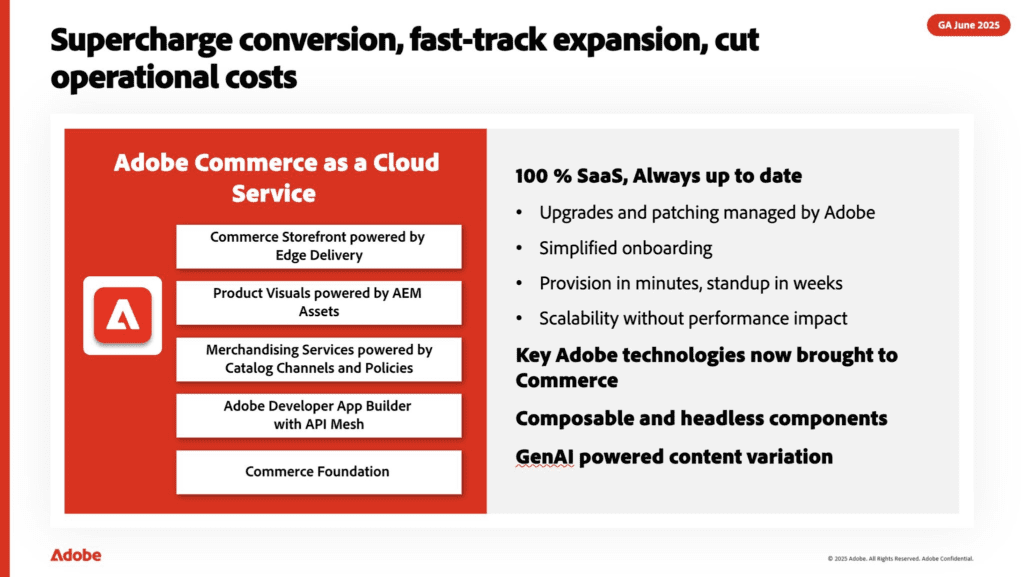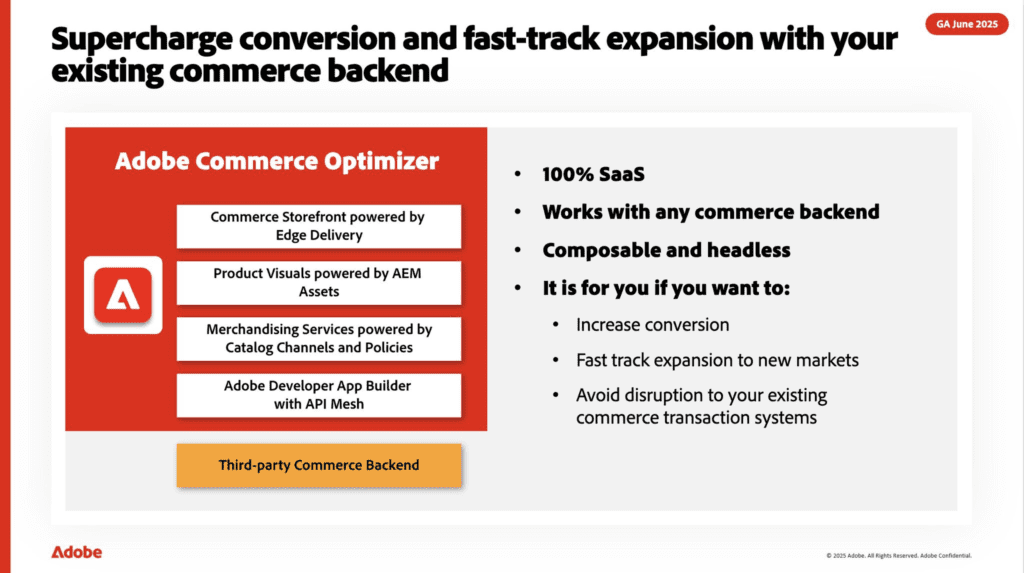LinkedIn over the past few weeks has been a buzz with the news that Adobe is releasing a SaaS based version of Adobe Commerce.
Adobe confirmed this at this year’s Adobe Summit in Las Vegas. The hype around this product had left many current users of Adobe Commerce either on-premise or an Adobe Cloud wondering what the next steps were going to be. Magento Open Source users were also sharing concerns that Adobe might not be supporting this platform in the future.
- So, what do we know so far?
- What is the value to the merchant?
- …and the biggest question on everyone’s lips… How will this affect current Adobe Commerce PaaS/On-premise and Magento Open Source customers?
Before we start, a few definitions to help;
Adobe Commerce SaaS – Cloud service ecommerce platform fully managed by Adobe.
Adobe Commerce PaaS / On-premise – ecommerce platform hosted by Adobe Cloud or third-party hosting company
Magento Open Source – ecommerce platform hosted by third-party hosting company
Let’s talk about what’s coming from Adobe
Adobe Commerce as a Cloud Service (SaaS) and Adobe Commerce Optimizer. These solutions are designed to boost merchant growth and conversions by offering exceptional scalability, AI-powered personalization, and high-performance storefronts.
Adobe Commerce as a Cloud Service (SaaS) provides a fully managed, always-updated SaaS platform. Key features include real-time scalability, automatic security, and advanced capabilities like GenAI content creation and intelligent merchandising, all powered by Edge Delivery Services.

Adobe Commerce Optimizer enhances any existing ecommerce systems by delivering the same powerful storefront and merchandising tools found in the cloud service. This allows businesses to improve shopping experiences and drive immediate ROI, regardless of their current transactional platform.

Adobe has said the general release of these products will be in June 2025.
What is the value of this to a merchant?
With any kind of SaaS-based product, there are pros and cons. Likewise, with on-premise.
There is no right or wrong way to use the Adobe Commerce / Magento Open Source application. Whether it be on-premise or PaaS based. It is completely down to the business needs and requirements.
What Adobe is doing with the Adobe Commerce SaaS platform is essentially restricting deeper customisation into the core functionality which does bring stability and overall control to a platform for a merchant.
Unlike Adobe Commerce and Magento Open Source on a hosted environment, flexibility is sometimes needed depending on the customers’ requirements. The cons of this is poor development which leads to merchant frustration. We’ve seen this so many times.
Adobe has promised a feature-rich roadmap, and operational cost reductions which is mainly down to a reduction in upgrades/security patches. However, this does depend on the commercials for Adobe SaaS which are yet to be released.
Adobe has also highlighted that there could be improvements in conversion rate due to the front-end technology that the platform sits on. The technology is the Edge Delivery Service (EDS) which was released earlier last year and has gained some momentum in the market with a few merchants adapting to this. One of the points that I think we need to be clear on is a frontend built within Hyvä on an Adobe Commerce on-premise or Magento Open Source on-premise can have exactly the same effect, the only difference is the level of flexibility in the customisation of the platform for the merchant.
One thing I am eager to get my hands on is the Adobe Commerce Optimizer tool that is released with Adobe Commerce SaaS. It has all the hallmarks of some of the technology that is already available within Adobe Commerce but it looks to have had a good face lift and additional features added. Again, this is early days but I do think this is a very strong feature and it’s something that has the potential to be a very strong product.
How will this affect current Adobe Commerce PaaS/On-premise and Magento Open Source customers?
DON’T PANIC! Adobe has confirmed that it will fully support Adobe Commerce on-premise and Adobe PaaS for the foreseeable future, as well as Magento Open Source.
Final thoughts
I’m excited and nervous. I think the move to SaaS is a good idea and provides merchants with a choice of three routes to market. The Generative AI features and App Builder technology should make development and content more open to merchants which is only a good thing.
Fingers crossed, with the release of Adobe Commerce SaaS, we see the other touchpoints that are available in the Adobe Experience League added. Example, Adobe Target, Adobe Analytics etc. This as a package would make Adobe Commerce SaaS a commercially viable product for a lot of medium to large businesses that want to scale.
That being said, the beauty of Adobe Commerce PaaS / On-premise or Magento Open Source is the flexibility and customisation. A prime example of this is Fluid Commerce’s PORTAL theme which was released in February 2025. Built on a Hyva frontend and available to sit on Adobe Commerce or Magento Open Source, this theme is a feature-rich enterprise B2B or B2C eCommerce platform. Check out PORTAL here > https://b2b.fluidcommerce.co.uk/
What many merchants and agencies are now asking is about the commercials. I’ve spoken to a few of the Adobe UK team and they are not yet aware of the costs. We’ll update this post once we know more.
You can watch the opening keynote from Adobe Summit here. Within this, Adobe introduced Adobe Commerce SaaS > https://business.adobe.com/summit/adobe-summit.html





